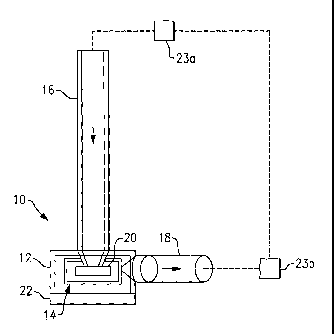Some of the information on this Web page has been provided by external sources. The Government of Canada is not responsible for the accuracy, reliability or currency of the information supplied by external sources. Users wishing to rely upon this information should consult directly with the source of the information. Content provided by external sources is not subject to official languages, privacy and accessibility requirements.
Any discrepancies in the text and image of the Claims and Abstract are due to differing posting times. Text of the Claims and Abstract are posted:
| (12) Patent: | (11) CA 2618493 |
|---|---|
| (54) English Title: | BYPASS PASSAGE FOR FLUID PUMP |
| (54) French Title: | PASSAGE DE DERIVATION POUR POMPE A FLUIDE |
| Status: | Deemed Expired |
| (51) International Patent Classification (IPC): |
|
|---|---|
| (72) Inventors : |
|
| (73) Owners : |
|
| (71) Applicants : |
|
| (74) Agent: | GOWLING WLG (CANADA) LLP |
| (74) Associate agent: | |
| (45) Issued: | 2013-04-23 |
| (86) PCT Filing Date: | 2006-08-08 |
| (87) Open to Public Inspection: | 2007-02-15 |
| Examination requested: | 2011-07-18 |
| Availability of licence: | N/A |
| Dedicated to the Public: | N/A |
| (25) Language of filing: | English |
| Patent Cooperation Treaty (PCT): | Yes |
|---|---|
| (86) PCT Filing Number: | PCT/US2006/030874 |
| (87) International Publication Number: | WO 2007019496 |
| (85) National Entry: | 2008-02-06 |
| (30) Application Priority Data: | ||||||
|---|---|---|---|---|---|---|
|
A fluid pump (10) includes a pumping chamber (14), an inlet (16) and an outlet
(18) fluidly connected with the pumping chamber, and a passage (24) fluidly
connected between the inlet and the outlet. Fluid flowing through the passage
bypasses the pumping chamber. In one example, the fluid pump (10) pumps
coolant within a vehicle cooling system between a heater core (23b) and a
vehicle engine (23a).
La présente invention concerne une pompe à fluide (10) comprenant un compartiment de pompage (14), une entrée (16) et une sortie (18) reliées fluidiquement au compartiment de pompage, et un passage (24) relié fluidiquement entre l'entrée et la sortie. Le fluide s'écoulant par le passage contourne le compartiment de pompage. Dans un exemple, la pompe à fluide (10) pompe du fluide de refroidissement dans un système de refroidissement pour véhicule entre un radiateur de chauffage (23b) et un moteur de véhicule (23a).
Note: Claims are shown in the official language in which they were submitted.
Note: Descriptions are shown in the official language in which they were submitted.

2024-08-01:As part of the Next Generation Patents (NGP) transition, the Canadian Patents Database (CPD) now contains a more detailed Event History, which replicates the Event Log of our new back-office solution.
Please note that "Inactive:" events refers to events no longer in use in our new back-office solution.
For a clearer understanding of the status of the application/patent presented on this page, the site Disclaimer , as well as the definitions for Patent , Event History , Maintenance Fee and Payment History should be consulted.
| Description | Date |
|---|---|
| Letter Sent | 2024-02-08 |
| Letter Sent | 2023-08-08 |
| Common Representative Appointed | 2019-10-30 |
| Common Representative Appointed | 2019-10-30 |
| Change of Address or Method of Correspondence Request Received | 2018-06-11 |
| Letter Sent | 2015-10-29 |
| Letter Sent | 2014-11-05 |
| Grant by Issuance | 2013-04-23 |
| Inactive: Cover page published | 2013-04-22 |
| Pre-grant | 2013-02-04 |
| Inactive: Final fee received | 2013-02-04 |
| Notice of Allowance is Issued | 2013-01-03 |
| Letter Sent | 2013-01-03 |
| Notice of Allowance is Issued | 2013-01-03 |
| Inactive: Approved for allowance (AFA) | 2012-12-17 |
| Letter Sent | 2011-08-05 |
| Request for Examination Requirements Determined Compliant | 2011-07-18 |
| All Requirements for Examination Determined Compliant | 2011-07-18 |
| Request for Examination Received | 2011-07-18 |
| Letter Sent | 2008-06-03 |
| Inactive: Declaration of entitlement - Formalities | 2008-05-20 |
| Inactive: Declaration of entitlement/transfer requested - Formalities | 2008-05-06 |
| Inactive: Cover page published | 2008-05-05 |
| Inactive: Notice - National entry - No RFE | 2008-05-01 |
| Inactive: Single transfer | 2008-03-25 |
| Inactive: First IPC assigned | 2008-02-28 |
| Application Received - PCT | 2008-02-27 |
| National Entry Requirements Determined Compliant | 2008-02-06 |
| Application Published (Open to Public Inspection) | 2007-02-15 |
There is no abandonment history.
The last payment was received on 2012-07-19
Note : If the full payment has not been received on or before the date indicated, a further fee may be required which may be one of the following
Please refer to the CIPO Patent Fees web page to see all current fee amounts.
Note: Records showing the ownership history in alphabetical order.
| Current Owners on Record |
|---|
| HANON SYSTEMS |
| Past Owners on Record |
|---|
| DENNIS KREFT |
| THOMAS LINCOLN |
| TIMOTHY WADE |